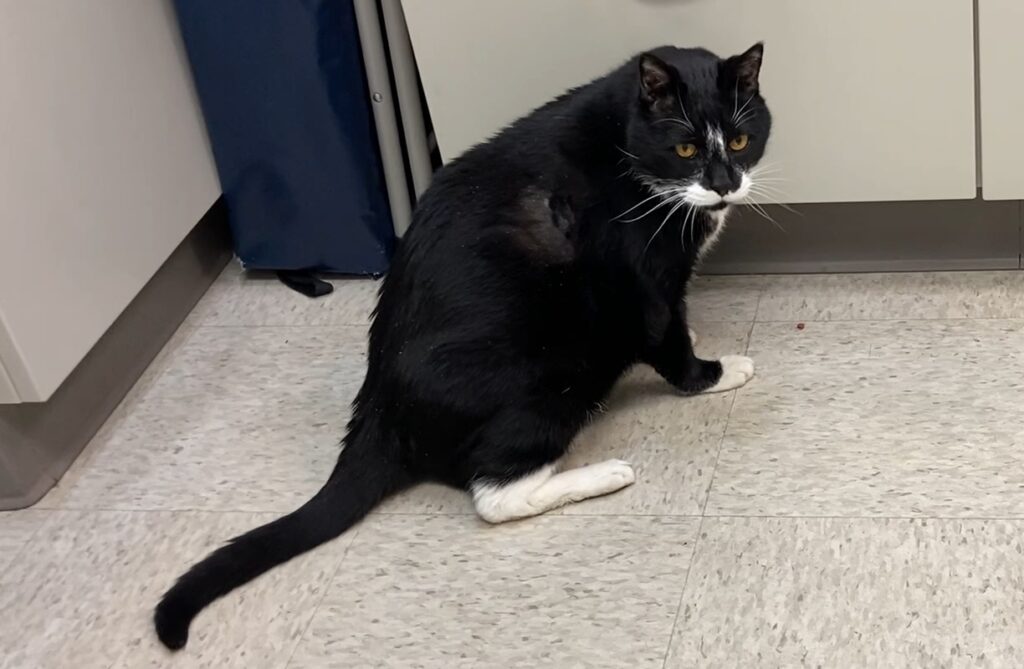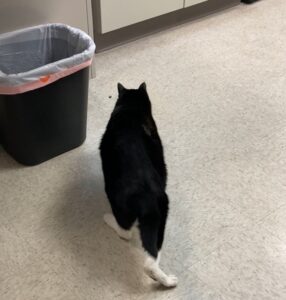
Diabetes is a condition where there is persistent high glucose (sugar) in the blood and the urine. Like humans, cat can develop diabetes. Which cats are at risk for diabetes? How do you diagnose diabetes in a cat?
Two previous posts addressed diseases that we tend to see in older cats, chronic kidney disease and hyperthyroidism. This post completes the trio by looking at feline diabetes.
diabetes in cats
Why do high levels of glucose occur in the blood and urine? Uptake of glucose by the muscle and fat cells in the body is dependent upon the hormone insulin. Insulin, produced by the “beta” cells in the pancreas, signals these cells to take up glucose. If the beta cells fail to produce enough insulin, these cells will not receive glucose, and, consequently, will not have energy for cellular functions. The glucose in the blood stream is then filtered out into the urine.
clinical signs of diabetes
Clinical signs of diabetes (Reference 1) are similar to those of hyperthyroidism and chronic kidney disease.
- increased thirst and urination
- weight loss
- increased appetite
In some cases of uncontrolled diabetes, a cat will start walking on his ankles, referred to as a “plantigrade stance”. Cats often recover a normal gait after several months of treatment for diabetes. Some practitioners use oral methylcobalamin, a form of vitamin B12, to help speed up recovery (Reference 2).
the feline diabetic
Most feline diabetics are similar to type 2 human diabetics: they have insulin resistance and beta cells that are not functioning normally.
- when muscle and fat cells become resistant to insulin, more insulin is needed to maintain glucose uptake.
- beta cells in the pancreas respond by producing more insulin.
- high levels of insulin trigger the liver to store glucose as glycogen instead of releasing it into the bloodstream (the cat is still able to get glucose from the GI tract).
- eventually, the beta cells cannot continue “hyper-secreting” insulin and fail, resulting in high levels of glucose in the blood, not in the cells. (Reference 3)
diabetes in cats – who is at risk?
- obese cats
- cats over 7 years old
- cats that are not very active
- male and neutered cats
- cats receiving steroids such as prednisolone
Obese cats are 2-4 times more likely to develop diabetes mellitus. Obesity leads to insulin resistance in the muscle and fat cells. However, many overweight cats never develop diabetes. They will have normal blood glucose values as long as the beta cells can produce enough insulin to suppress glucose production in the liver.
diagnosing diabetes in cats
Persistent high glucose levels in the blood (hyperglycemia) and urine (glycosuria) accompanied by one or more of the clinical signs above support a diagnosis of diabetes mellitus. A thorough history needs to be taken and a complete physical examination done. Diagnostic blood work will include routine chemistries, a complete blood count, urinalysis, urine culture or bacterial assay, and T4 measurement.
Why measure T4?
Excess thyroid hormone increases glucose production in the liver. If a cat is hyperthyroid, the hyperthyroidism needs to be managed in order to control the blood sugar.
One of the challenges to diagnosing diabetes in cats in the veterinary clinic is stress hyperglycemia. A cat’s blood glucose values can become falsely elevated due to the stress of the car ride, the exam and other factors. If the blood glucose is high enough, glucose spills over in the urine, also causing a false positive. Options to rule out stress hyperglycemia include (Reference 4):
- repeating the lab work on a subsequent visit with the patient on pre-visit sedation
- collecting a urine sample at home
- measuring blood glucose at home
- adding a serum fructosamine to the blood panel
Fructosamine measures the average of the blood glucose over the two weeks preceding the sample collection and consequently should not be affected by stress hyperglycemia. Fructosamine may not be accurate if the cat became diabetic within the past two weeks or if the cat has uncontrolled hyperthyroidism (Reference 1)
Once your cat is diagnosed with diabetes, what happens next?
The next post will address the treatments available to the diabetic cat and how the chosen therapy must be monitored.
 references
references
- Sparkes, A (chairman), ISFM Consensus Guidelines on the Practical Management of Diabetes Mellitus in Cats, Journal of Feline Medicine and Surgery (2015) 17, 235-250
- Sereno, R. Managing complications in diabetic cats, DVM 360:article 5/1/2011. https://www.dvm360.com/view/managing-complications-diabetic-cats (viewed 11/2023)
- Clark M, Hoenig M. Feline comorbidities: Pathophysiology and management of the obese diabetic cat. Journal of Feline Medicine and Surgery. 2021;23(7):639-648. doi:10.1177/1098612X211021540
- American Association of Feline Practitioners, Diabetes Educational Toolkit, https://catvets.com/diabetes-toolkit/troubleshooting, viewed 11/2023

 references
references